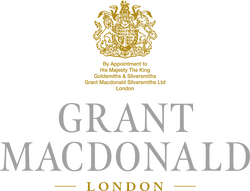Grant Macdonald London has always been known as a workshop that keeps the traditional – in some cases ancient – crafts of the master silversmith, goldsmith and journeyman crafts alive. However, we have also always blended high tech innovation into our work as well.

Our interest in technology began when we developed a signature style called ‘Electro-texturing’ in the late 1960s and early 70s. Using the electroforming technique and introducing small alien particles onto the surface of the silver created small bobbles as a texture on the surface. It was a step away from traditional silver surfacing patterns, and also made pieces much more practical to handle, providing grip and hiding unwanted fingerprints and marks from daily use.

In the 1980s, we achieved another industry first by adapting a 60W laser to cut silver and gold, which was previously considered nearly impossible (and impractical) due to the highly reflective nature of precious metals. This meant we also needed to develop new techniques for soldering pieces together (because the laser cuts were so fine) and even expanded from gold and silver luxury goods into gold components for radar systems for the RAF

The use of lasers is evident in various works, including the Dresden Orb and Cross as well as the Qatar Tennis Open Trophies in silver and the Queen Elizabeth II Jubilee bowl in 18ct gold. However, by 2003 even lasers were a bit old fashioned compared to the new generation of rapid prototyping tools known as 3D printers.

As well as creating master patterns, this new technology, capable of making far more complex structures than possible by hand, was an exciting boost to our customer experience. It means we could go beyond the traditional artist rendering of a proposed design and make 3D prototype examples to show the client. The ability for the customer to hold and feel the handle of a knife or the stem of a goblet was a hugely important step forward in offering the highest possible standards of service.

Our goal since the 1960s has been using technology to make complex designs that would have been impossible in the past, and create prototypes faster. It has enabled us to offer our customers even more input into the design process. We can now take a client from a paper sketch to a physical model in a couple of days, we can take complex sculptures of animals and scale them up or down with ease, and make adjustments that in the past would have meant starting over from scratch.
Grant Macdonald London’s end-to-end design process is now faster and more flexible than ever before, and we’re constantly finding new ways to blend new high tech approaches with traditional skills like hand-chasing, engraving, carving and polishing to produce masterpieces that are as complex as they are beautiful, and as original as the ideas of our clients.
